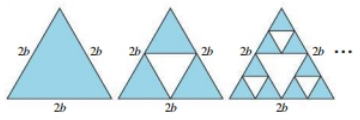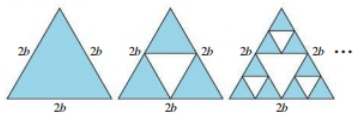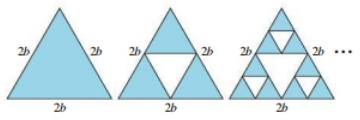
To find: The infinite series.
Answer to Problem 68RE
The answer:
Explanation of Solution
Given information:
The figure is:

Calculation:
The area of the triangle is:
At each step, take into account the deleted triangles' surface area. Due to the removed triangle's side being bb, the area of the single removed triangle in the first step is exactly a quarter of the area of the original triangle. To put it another way, this region.
The size of the three new triangles that are removed in the second step is three times greater than the area of the triangle that was removed in the first step, i.e.
The area of the removed triangles in the subsequent stage is always three times the quarter of the area of the triangles that were removed in the preceding step.
Therefore, the required infinite series is:
To find: The sum of the infinite series and total area removed from the original triangle.
Answer to Problem 68RE
The answer:
The total area removed from the original triangle is
Explanation of Solution
Given information:
The figure is:

Calculation:
From part
Since,
Therefore, the required total area removed from the original triangle is
To find: The every point on the original triangle removed or not.
Answer to Problem 68RE
The answer: No
Explanation of Solution
Given information:
The figure is:

Calculation:
For instance, consider the sides of the triangle, always remove points whose distance from the ends of the given side is a rational number. More precisely,
As a result, those points will never be eliminated if their distance from the side's end has an unreasonable value.
Therefore, the required no every point on the original triangle removed.
Chapter 9 Solutions
Advanced Placement Calculus Graphical Numerical Algebraic Sixth Edition High School Binding Copyright 2020
- 3) If a is a positive number, what is the value of the following double integral? 2a Love Lv 2ay-y² .x2 + y2 dadyarrow_forward16. Solve each of the following equations for x. (a) 42x+1 = 64 (b) 27-3815 (c) 92. 27² = 3-1 (d) log x + log(x - 21) = 2 (e) 3 = 14 (f) 2x+1 = 51-2xarrow_forward11. Find the composition fog and gof for the following functions. 2 (a) f(x) = 2x+5, g(x) = x² 2 (b) f(x) = x²+x, g(x) = √√x 1 (c) f(x) = -1/2) 9 9(x) = х = - Xarrow_forward
- practice problem please help!arrow_forward13. A restaurant will serve a banquet at a cost of $20 per person for the first 50 people and $15 for person for each additional person. (a) Find a function C giving the cost of the banquet depending on the number of people p attending. (b) How many people can attend the banquet for $2000?arrow_forwardAlt Fn Ctrl 12. Find functions f and g such that h(x) = (fog)(x). (a) h(x) = (x² + 2)² x+1 (b) h(x) = 5 3arrow_forward
 Calculus: Early TranscendentalsCalculusISBN:9781285741550Author:James StewartPublisher:Cengage Learning
Calculus: Early TranscendentalsCalculusISBN:9781285741550Author:James StewartPublisher:Cengage Learning Thomas' Calculus (14th Edition)CalculusISBN:9780134438986Author:Joel R. Hass, Christopher E. Heil, Maurice D. WeirPublisher:PEARSON
Thomas' Calculus (14th Edition)CalculusISBN:9780134438986Author:Joel R. Hass, Christopher E. Heil, Maurice D. WeirPublisher:PEARSON Calculus: Early Transcendentals (3rd Edition)CalculusISBN:9780134763644Author:William L. Briggs, Lyle Cochran, Bernard Gillett, Eric SchulzPublisher:PEARSON
Calculus: Early Transcendentals (3rd Edition)CalculusISBN:9780134763644Author:William L. Briggs, Lyle Cochran, Bernard Gillett, Eric SchulzPublisher:PEARSON Calculus: Early TranscendentalsCalculusISBN:9781319050740Author:Jon Rogawski, Colin Adams, Robert FranzosaPublisher:W. H. Freeman
Calculus: Early TranscendentalsCalculusISBN:9781319050740Author:Jon Rogawski, Colin Adams, Robert FranzosaPublisher:W. H. Freeman
 Calculus: Early Transcendental FunctionsCalculusISBN:9781337552516Author:Ron Larson, Bruce H. EdwardsPublisher:Cengage Learning
Calculus: Early Transcendental FunctionsCalculusISBN:9781337552516Author:Ron Larson, Bruce H. EdwardsPublisher:Cengage Learning





